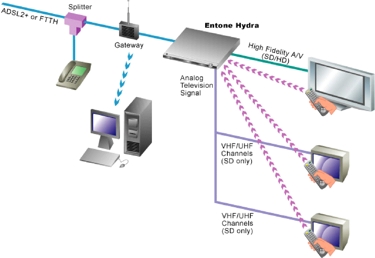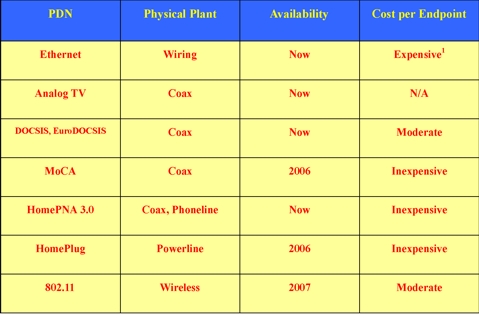|
 |
|
Getting IP television (IPTV) signals to the consumer's television in the home can be one of the largest difficulties faced by IPTV service providers. In the early years of TV, a simple cable was installed from the rooftop antenna to the one TV in the household. TV became more popular and multi-TV homes became the norm; homes built in the past 50 years have coaxial networks at multiple locations in the home. As cable TV has replaced rooftop antennas, premise distribution hasn't changed much because cable TV and off-air signals are nearly identical. Even digital cable TV signals are compatible with existing in-home coaxial networks, a design feature that is a testament to the value of a ready-to-use premise distribution network (PDN). Today most homeowners give no more thought to having TV service in every room than electricity, heating or any other necessary utility.
IPTV service providers face a new challenge, because their television signals are not natively compatible with in-home coaxial or telephone line networks. IP services are carried to the home over a wide area network or WAN (e.g. xDSL, fiber to the premise or wireless) and then converted to a different network technology for distribution within the residence. There are a few differences between PDN and WAN technologies. In general, WANs are "carrier grade" networks designed for public network service providers, whereas PDNs are "consumer grade" and only appropriate for networking within a single residence. Some characteristics that distinguish WANs include:
§ High powered amplifiers and precision receivers suitable for wide area distribution and reception
§ Good immunity from noise and impairments common in wide area networks
§ Remote provisioning features that enable service providers to add or remove features on a customer-by-customer basis using automated systems
§ Security features designed to protect against malicious and accidental interference that might affect other customers on the same network
Meanwhile, PDNs are more suitable for consumer networks and have the following characteristics:
§ Components optimized for high-volume, low-cost deployments
§ Relatively simple to setup and configure without extensive technical skills and training
§ Suitable for networking within the home, e.g. to share a personal video recorder from room-to-room or to share audio and video assets on a PC for viewing on a TV
|
For more reasons than IPTV, IP has emerged as an essential service that mandates a premise distribution architecture.
Requirements for PDN
There is general consensus that installing new Ethernet wiring is not a viable answer to the premise distribution requirements of IPTV and other innovative IP services. Whatever technology is adopted must meet basic conditions:
§ No new wires or cables
§ Global applicability
§ At least 100Mb/s available bandwidth
§ Enables any-to-any connectivity within a residence
§ Provides guaranteed quality of service
These requirements have spawned a new generation of PDN technologies. Home networking has become a multi-billion dollar industry in recent years as more and more IP devices provide entertainment, information and education.
Candidate PDN Technologies
There are several existing and emerging technologies that are contending to become the IPTV premise distribution network of choice. It's not clear that a single winner will emerge. Cable, satellite and telephone network service providers could make different selections based on their specific requirements. It's also likely that different regions will endorse different technologies. Finally, many of these technologies are still under development and questions remain about actual performance in real homes.
Analog television is the most prevalent form of television signal distribution worldwide for cable and terrestrial broadcasting. It is a low-cost, well-proven and widely available technology that is suitable for both wide area and premise distribution that dates back to the 1950's. To utilize analog TV distribution for IPTV requires a home video gateway that accepts IP signals and converts the digital TV signal to analog. Once a digital IPTV signal has been converted to analog it is possible to transmit the analog signal over the in-home coaxial network and to receive the analog signal with a standard television tuner. Analog television distribution has the lowest cost of any distribution technology because it reuses existing coaxial wiring and doesn't require a set-top box at each
viewing location. The primary disadvantage is that analog signals tend
to be lower quality than digital signals and doesn't support HDTV,
except at the primary viewing location. Still, roughly 75% of the
television viewed in North America is analog television and it is very
popular and cost effective.
|
|
|
 |
|
Ethernet is the most prevalent IP network technology in use today. It
operates over Category 5 (or better) wiring, which is widely available
in office buildings but very few homes have Category 5 wiring. There
are cost, complexity and cosmetic reasons that new wiring is not a
viable alternative for existing homes.
DOCSIS (Data Over Cable Service Interface Specification) and its
European analogue, EuroDOCSIS, are more commonly referred to as
"cable modem." DOCSIS is a two-way digital technology for IP
transmission that was designed for wide area networking. A typical
cable modem termination system (CMTS) serves thousands of subscribers
over distances ranging many miles. Although not strictly a PDN
technology, DOCSIS, especially the forthcoming version 3.0, is
suitable for IPTV delivery from a service provider directly to an end
customer's set-top box or PC. However, several features that make
DOCSIS appropriate for wide area service delivery also make it too
costly to be a viable PDN technology for a single residence.
Multimedia over Coax Alliance (MoCA) is an industry standard for IP
over existing coaxial networks. It meets all the major criteria for a
PDN, including room-to-room connectivity. One of the advantages MoCA
offers is a frequency agile bandplan, which means that MoCA can be
configured to use frequencies that don't interfere with other services
on the network. For example, several cable TV operators have endorsed
MoCA in part because it can coexist with DOCSIS over in-home coaxial
networks. Presently the MoCA standard is based on technology
implemented by Entropic Communications, but the stated objective of the organization is to enable a
licensing model for silicon manufacturers. Expect to see MoCA deployments in
2006.
Home Phoneline Networking Alliance (HPNA) began as an industry standard body in
1998 for data communication over phonelines. |
Releases 1.0 and 2.0 of the
specification provided 1 Mb/s and 10 Mb/s respectively. Release 3.0, which was
ratified in June 2003, significantly enhanced the specification and made it a
viable candidate for IPTV distribution:
§ Increased bandwidth from 10 Mb/s to over 100 Mb/s
§ Defined quality of service features and control
§ Added support for operation over coax as well as phonelines
In addition, the ITU-T formally adopted HPNA 3.0 as Recommendation G.9891
making HPNA 3.0 and attractive choice for telephone companies worldwide. The
ability to operate over both coaxial and phoneline networks has broader
applicability on a global basis as many countries do not have extensive in-home
coaxial networks. HPNA is an open standard, meaning that silicon vendors are
able to develop products to the HPNA specifications through the Alliance's
adopter program. Deployments of HPNA 3.0 technology started in 2005.
HomePlug Powerline Alliance (HomePlug) is an industry alliance that has
developed a standard for IP connectivity over powerlines. This has obvious
appeal, as powerlines are even more ubiquitous and global than phonelines or
coax. By definition, there is always a power outlet where a TV is located
whereas it's less certain that either a coax or phoneline outlet is near the
ideal TV location. HomePlug 1.0 was a baseline standard for 10 Mb/s IP
connectivity that was adopted in 2002 and has been available in products since
for several years. In August 2005 the HomePlug Alliance approved and released
the HomePlug AV standard, which added quality of service features and support
for
speeds in excess of 100 Mb/s. Deployments for HomePlug AV are anticipated
to begin in 2006.
|
|
|
|
 |
|
Figure 1 |
|
 |
|
Figure 2, Premises Distribution Matrix |
|
Wireless technologies have great appeal for reasons of convenience, but
wireless technologies to date have lacked the bandwidth, quality of
service and robustness to support IPTV services. There is a considerable
amount of activity by standards bodies and individual companies to remedy
these shortcomings. The IEEE body, which ratifies and publishes the 802.11
series of recommendations, is developing the 802.11n standard to address
the needs of IPTV services. The 802.11n specification will offer over 500
Mb/s of bandwidth and will utilize some advanced antenna technology to
support quality of service requirements. The 802.11n standard will utilize
spectrum that is compatible with worldwide frequency allocations. However,
the 802.11n is not expected to be ratified until late 2006 with products
to follow thereafter. Other companies have demonstrated success using
so-called intelligent antenna technologies to improve performance of
existing wireless standards. These efforts have yielded results on the
order of 20-30 Mb/s in many circumstances, which is enough bandwidth for
multi-channel IPTV service.
Summary
Home networking is an active area of new technology development today. It
is generally agreed that any new PDN will support IP and will not require
new wiring in the home. Phonelines, powerlines, coax and wireless are all
candidate networks. Some, but perhaps not all, of these technologies will
gain critical mass and become widely deployed. It's possible that
telephone, cable and satellite TV providers will chose different PDN
technologies. It's also quite possible that regional differences will |
have an impact on the adoption of different
technologies. For example, countries that don't have extensive
existing in-home coax infrastructure won't select a coax technology.
It could be that a mixture of technologies, even within one service
provider in one region, will be adopted. For example, a service
provider might select an inexpensive wireline solution as their
standard deployment architecture, then selectively deploy wireless for
customers that want mobility. Whatever ultimately plays out one is for
certain that there will be a lot of interest and competition in home
networking for years to come.

|
|
 Mark
Evensen, Co-founder and VP of Product Development Evensen has been
designing and deploying video solutions for over 15 years. He was the
architect of the world's first video over DSL deployment and knows
intimately what it means to design and develop an end-to-end telco
video architecture from the ground up. Mark
Evensen, Co-founder and VP of Product Development Evensen has been
designing and deploying video solutions for over 15 years. He was the
architect of the world's first video over DSL deployment and knows
intimately what it means to design and develop an end-to-end telco
video architecture from the ground up.
Entone Technologies
1840 Gateway Drive, Suite 200
San Mateo, CA 94404
Phone: (650) 378-1215
Fax: (650) 240-0135
|
|
|
|